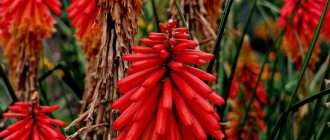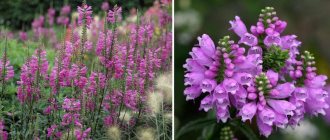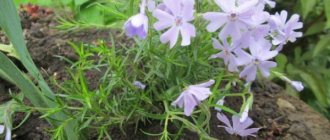Author: Elena N. https://floristics.info/ru/index.php?option=com_contact&view=contact&id=19 Category: Garden plants Published: February 12, 2019Last edits: January 20, 2021
- When to plant
- Rules of care
- Lupine angustifolia, or blue
Did you know that lupine is not only a beautiful, but also a very useful plant? Lupine oil is not inferior in quality to olive oil, but does not contain substances that slow down digestion. Lupine is both an ornamental, green manure and medicinal crop. The root system of this plant is capable of accumulating and converting nitrogen into a form that is easier for plants to absorb. Lupine cultivation began about four thousand years ago.
If you are interested in this culture, then from our article you will learn:
- When and how to sow lupine;
- How to care for decorative lupine;
- What types and varieties of lupine are most often grown in cultivation?
Planting and caring for lupine
- Planting: sowing seeds for seedlings - in early March, planting seedlings in the ground - at the stage of development of 2-3 leaves. Sowing seeds directly into the ground - before winter or in April.
- Flowering: within three weeks from late May or early June.
- Lighting: bright sunlight.
- Soil: any soil, but preferably loamy with a reaction ranging from slightly alkaline to slightly acidic.
- Watering: abundant in spring, moderate the rest of the time.
- Feeding: from the spring of the second year, once a season with mineral complexes that do not contain nitrogen.
- Reproduction: seed.
- Pests: aphids, germ fly larvae, root nodule weevils.
- Diseases: root and gray rot, Fusarium wilt, Phomopsis, rust, spotting, viral mosaic.
Read more about growing lupine below.
Lupine (lat. Lupinus) is a genus of the Legume family, which is represented by both annual and perennial herbaceous plants, shrubs, subshrubs and subshrubs. Translated from Latin, “Lupus” means “wolf”, and the plant itself is sometimes popularly called “wolf bean”. Lupine flowers are widespread in nature in two regions: in the Mediterranean-African region there are 11 annual and 1 perennial species of lupine, and in the Western Hemisphere, from Patagonia to Alaska and from the Atlantic to the Pacific Ocean, about 200 species of lupine grow. Among the American species, the only cultivated species are the variable lupine, which was cultivated by the Incas, and the many-leaved lupine.
The lupine plant is drought-resistant, so some of its species grow in the deserts of Arizona, California, Texas, Peru and Chile, and even in the Sahara. In 1911, the English breeder George Russell created highly decorative species of lupins, which were called “Russell hybrids” and have since been a popular decoration for gardens and flower beds.
- Master class - how to get 90% rooting of surfinia (petunia) cuttings?
What to do after flowering
If lupine is grown solely to decorate the site, then it is better to cut off the fading inflorescences. In this case, the plant may bloom again. If you need to collect seeds, you need to wait until they form.
It is important not to miss the moment. When ripe, the seeds may fly out of the bean. They need to be collected before the box cracks. After the final flowering, it is advisable to prune the bush. Not only faded flower stalks are removed, but also foliage.
Perennial bushes are additionally hilled. This will help prevent exposure of the root collar, which negatively affects the plant. Before wintering, it is useful to sprinkle lupine with a layer of sawdust. This will help protect the plant from hypothermia during the cold season.
The photo of lupins shows the variety of varieties used by flower growers. Both annual and perennial variations are popular. Plants with different colored corollas are in demand. Most often this is a smooth transition of shades from white to yellow, red or blue-violet. Different varieties may bloom at different times, but always require a minimum of attention from the grower.
Botanical description
The root system of lupins is taprooted, sometimes going 2 meters deep. The roots are covered with small swellings that absorb nitrogen from the air and enrich the soil under the plant with it. The stems are woody or herbaceous, the branches are creeping, protruding or erect. Lupine leaves are alternate, on long petioles, palmately compound, connected to the stem by a leaf cushion with a long stipule. An inflorescence is an apical raceme on which a large number of flowers are arranged whorled, semi-whorled or alternate. The size of the brush in some species reaches one meter, the color of the flowers is varied - yellow, white, red, pink, cream and purple lupins, as well as all shades of purple.
Lupine seeds of different species differ in shape, size, and color. Lupine beans of Mediterranean species are larger than American ones. When drying, the beans crack and scatter seeds around them - very small grains of lupine. Lupine not only decorates flower beds, it is also grown as green manure: lupine stems and leaves rotted in the ground become an excellent fertilizer. In addition, fodder lupine is grown.
Description of lupine with photo
It is a naturally growing herbaceous plant with long, stiff stems and large, green, palm-shaped leaves divided into 10-17 leaflets. Depending on the varietal group, the height of the plant varies from 50 to 120 cm, and the width is 50-90 cm.
Decorative allium onion - planting and care
Fragrant lupine flowers are collected in impressive, up to 50 cm inflorescence-spikes, which are located significantly higher than the foliage. Flowers have what is called a butterfly structure.
Their largest upper lobe is called a sail, the two lateral ones are called blades or wings, and the two lower ones form a boat. In the original species, dark blue, purple and pink shades predominate on the upper and lateral petals, and the sail is usually white.
The color of lupine varieties covers almost the entire color gamut: white, yellow, blue, purple, lilac and often bicolor.
Mix of Russell hybrids “Tutti-frutti”
Cultivars and hybrids with yellow, white and red flowers look especially beautiful. Multileaf lupine blooms in June-July and can repeat flowering in September on new peduncles. Lupine fruits are brown, pubescent pods 4 cm long, containing 5-9 seeds.
Lupine roots, which grow deep into the ground, coexist in symbiosis with atmospheric nitrogen-fixing bacteria, thanks to which the plants are able to accumulate nitrogen in the soil, which, in turn, makes them an ideal material as green bio-fertilizers.
Initially, the flower was brought to northern Europe precisely for the purpose of improving soil conditions. However, annual lupine (Lupinus angustifolius) is best suited as a green manure, which is used to sow fields.
Growing lupine from seeds
Sowing seeds
Lupine seeds are sown for seedlings in a loose soil mixture for seed germination, consisting of peat (one part), turf soil (one part) and sand (half part). Before sowing, the seeds are mixed with crushed root nodules of old lupins to accelerate the growth of nitrogen-absorbing bacteria. Shoots will appear in a week or two, and if you want all the seeds to germinate at the same time, you need to cover the crops with damp gauze and keep them warm.
Growing seedlings
It should be recalled that seed propagation does not guarantee that young lupins will inherit the color and other characteristics of the mother plants. Lupine is usually grown from seeds for the purpose of breeding experiments. Purple and pink colors are dominant, so they can be preserved in the next generation, but the white color will most likely be lost during seed propagation. After 2-3 true leaves appear, the seedlings are planted in a permanent place - do not delay replanting, since the tap root system will become a significant hindrance to you.
How to get lush blooming lupins
of fasciation can be observed in lupine . This term refers to the displaced, thickened arrangement of leaves. Typically, a lupine leaf has 5-6 lobes, and in a plant with a fasciated stem this number can be 2-3 times larger. Such specimens also have more leaves in the rosette and the inflorescences are more lush due to the denser arrangement of flowers in them. Flowering stems, including lateral ones, can branch.
Fasciation is a fickle phenomenon; it occurs when the plant is fed abundantly . New rosettes are formed from new buds. In order for leaves with a large number of lobes to form in them, subsequently fasciated flower stems, lupins need to be well fed and, in dry weather, sufficient watering must be provided.
Knowing this feature, already at the stage of growing seedlings, you can select plants with leaves with ten or more lobes . They will subsequently produce plants with fasciated stems, i.e. with more luxuriant flowering.
If such selection is carried out over 2-3 generations of plants, it is possible to develop very decorative forms with an increased number of leaves in rosettes and lush inflorescences and branching flower stems.
Planting lupine
When to plant
If you use the seed propagation method, sow the seeds in early spring, at the beginning of March. If you decide to sow directly into the ground in the spring, then sowing lupine is carried out in April, after the snow has melted, but the site must be ready in the fall. Many gardeners prefer to sow lupine before winter, at the end of October. There are many advantages in autumn sowing and almost no contraindications: the seeds will not have time to germinate before winter, since they will ripen in the ground in very comfortable conditions. The seeds are planted in the soil to a depth of 2 cm, then the area is mulched with peat, in the spring the lupine will sprout and bloom by August.
If you grow lupine using seedlings, then, as already mentioned, planting of lupine is carried out when the seedlings have 2-3 leaves, and do not delay so that there are no problems with replanting.
- How to prune garden hydrangea
How to plant
Slightly acidic or slightly alkaline loamy or sandy loam soil in a sunny area is most suitable for lupins. To prepare the site for the spring planting of lupine seedlings, in the fall the acidic soil is limed with dolomite or lime flour at the rate of 5 kg per 1 m², and this will be enough for 3-4 years. Too alkaline soil is dug up with peat with the same calculation - 5 kg per 1 m². In the spring, sprouted and strengthened seedlings are planted in soil prepared in the fall at a distance of 30-50 cm from each other.
Reproduction
Seed ripening
It is not difficult to plant any of the lupine varieties on your site; to do this, you just need to choose a suitable place, select the soil and plant the plant. The very next year after planting, you will be able to admire the flowers and inhale the fragrant aroma of the trunk.
The plant is propagated in two ways:
- sowing seeds
- separation of a bud with a root collar
The first one is usually the most effective; from purchased seeds the exact type of lupine you buy will definitely sprout.
When collecting seeds yourself, you should not hope that after sowing you will receive an identical standard. Usually flowers are pollinated and change more and more each time.
Some gardeners practice cuttings, but this method is not always effective. Very often, cuttings do not take root and simply die without sprouting. Therefore, the most common method is seed; grains are sown either in open ground or seedlings are grown.
Seed method
Types of Lupine Seeds
Lupine reproduces well by seed ; to do this, simply sow the prepared seeds in the ground, water regularly, and within a month, with proper care, the first shoots will appear.
Germination of lupine seeds is carried out in two ways:
Young plant in open ground
Sowing in open ground
- The procedure is carried out in early spring or late autumn, and the soil temperature must be taken into account. To prevent the seeds from rotting and germinating in the very near future, the soil must warm up to +3 degrees, while excess moisture must leave it, otherwise the lupine will not sprout.
- The soil is well loosened, weeds, roots, and stones are removed. Clay, sand, dolomite flour, mineral fertilizers, ash are added to the future place of residence of the lupine, and dug up again. Make shallow furrows up to 2 cm deep and sow the prepared seeds there. It is advisable to mulch the planting area with peat.
- After the seedlings appear, wait for a couple of leaves to appear, then, if necessary, thin out the bed or transplant the plants to a permanent place. For normal development and full flowering, adult trunks should be located at a distance of 30-40 cm from each other. Dense lupine plantings will not allow the trunks to bloom normally; the plants will be fragile and not lush.
Grown seedlings
Growing seedlings
- This is done in order to plant stronger plants in the soil that can grow and develop faster. Typically, seedlings are sown in containers; the soil for this is prepared from equal parts of garden soil, peat and sand. The ingredients are thoroughly mixed, the resulting mixture is filled into containers, watered generously and allowed to warm up throughout the day.
- After this, the prepared seeds are laid out on the surface and the crop is sprinkled with a thin layer of the same soil or peat. Water again, create a greenhouse effect using glass or film and place the container in a warm place. The crops are ventilated every day and watered as necessary.
- After 10-14 days, the first sprouts will appear on the surface, after which the film or glass must be removed and the container placed on a sunny window. After 2-4 true leaves appear, lupine is planted in open ground.
- It is important to prevent the lupine from overgrowing; the stem-horse system will not take root well in a new place if the plant is not planted at a young age.
When growing seedlings, it is worth calculating the timing in advance; usually about three weeks pass before the transplantation period. It is important that the snow has already melted and the earth has warmed up to the desired temperature.
Before sowing the seeds, be sure to treat them. To do this, prepare a weak solution of potassium permanganate or soak the grains in a fundozol. It is advisable to keep the seeds for at least a day, so that diseases and pests will not harm the young seedlings.
Reproduction by bud
Plants grown in pots
To obtain an identical standard with exact preservation of all characteristics, it is best to propagate it by separating the basal buds with a piece of the neck. This is usually done in the spring, when the plant is just leaving winter.
The subtleties of reproduction are as follows:
- From the selected trunk at the beginning of spring, a piece of the stem with a young shoot is separated with a sharp knife . It is important that the shoot has a piece of the horse's neck, otherwise the formation of roots may not occur.
- It is advisable to treat the sections with charcoal , and place the cut cuttings in wet sand.
- Throughout the entire period, it is necessary to observe the watering regime , ensuring that the sand is constantly wet.
- Under proper conditions, roots will appear within 2-3 weeks , and the sprout will begin to actively grow and develop.
You should not divide the bush for propagation; the taproot may not survive such stress and the plant will die completely.
For such purposes, side shoots are used after the brush has been trimmed. At the end of summer, the plant's basal rosettes are used for this method of propagation.
After propagation in this way, lupine will bloom in the same year at the end of summer.
Lupine care
Rules of care
Caring for lupine is not difficult. If you grow perennial lupine, during the first year you will have to periodically loosen the soil in the area and remove emerging weeds. Over time, adult plants will need to be earthed up, since their root collar is gradually exposed, and the lateral rosettes become isolated. After five to six years of growth, the old bushes will have to be removed, since the middle part of the bush dies off and the quality of flowering noticeably deteriorates. Take care of supports for tall lupins so that their stems do not break from the wind.
If you want lupins to bloom until the cold weather, trim off faded inflorescences without allowing them to dry out. After such manipulation, perennial species are able to bloom twice per season. Lupines need to be watered moderately, but in spring watering should be plentiful.
Fertilizer
Lupines are fed in the spring, in the second year of growth, with mineral fertilizers that do not contain nitrogen: approximately 20 g of superphosphate and 5 g of calcium chloride are added per 1 m² of area. Fertilizing is carried out every spring until it is time to plant new lupins.
Pests and diseases
During the budding period, lupine can be affected by aphids, and at a later time - by the larvae of the sprout fly and root nodule weevils. They will have to be combated by spraying plants with insecticides.
Among the diseases that are dangerous for lupine are rot (gray and root rot), Fusarium wilt, spotting and mosaics, Phomopsis and rust. You won’t have to fight diseases and pests if you follow the agrotechnical requirements for lupine, and first of all, the rules of crop rotation: lupine can be re-placed on the site only after three years. The best precursor for lupine is cereals.
Technology for planting seeds in open ground
Let's move on to the next section of our article - we are interested in perennial lupins, planting and further care for them. Since perennials are frost-resistant, even with autumn sowing the germination rate will be high. It reproduces excellently by self-seeding, but only if it is not a hybrid lupine. Sprouts will appear, but they will not retain the qualities of their “parents”. Breeders advise planning planting at the beginning of April - end of May.
Location on
For a plant such as perennial lupine, planting recommendations will be as follows:
- Depth – no more than 2 cm.
- The distance in one row is from 8 to 10 cm.
- The distance between two rows is up to 12 cm, preferably 10.
With the appearance of the first shoots, you need to loosen the ground and remove weeds. Water moderately, in small doses, every 3 days. When the seedlings reach 10 centimeters, they are carefully transplanted.
Growing seedlings
You can also start seedlings of perennial lupine, the cultivation of which begins at the end of winter. Do not delay the deadlines in order to plant in open ground in April. Of course, a lot depends on weather conditions. If the threat of frost has passed, you can begin planting.
Since lupine is a plant with rather large seeds, we suggest planting them in separate cups. You will automatically solve the dive problem.
Lilac lupine flowers
- A regular substrate, which is sold in flower shops, will do.
- Seeds are placed to a depth of 1 cm. Drainage holes in each glass are one of the prerequisites.
- Provide moderate watering, and harden off a little before planting in a flowerbed. The seedlings are gradually accustomed to natural conditions: wind, sun and cold weather. They are taken outside for several hours every day for 10 days.
Further planting of seedlings in the flowerbed
So, your seedlings have grown stronger and hardened - what to do next? First of all, choose a location (an area well lit by the sun) and prepare the soil. A slightly acidic or slightly alkaline environment will be just right.
- The recommended distance between seedlings is 30-50 centimeters.
- Humus is first placed in each hole.
- When disembarking, the transshipment method is used. That is, fill the seedlings with water and wait about an hour. Then they carefully take it out along with a lump of earth and place it in the hole. Make sure that the integrity of the roots is not damaged.
- Water generously.
Pink lupine buds
As a rule, annual lupine will bloom in the year of planting, although the bushes will be small. Some people even cut off the faded buds of perennials so that the plant does not waste energy on producing seeds. This guarantees good rooting and lush flowering next year.
How to collect lupine seeds
As soon as the lupine fruit ripens, it cracks and the seeds scatter in all directions. To prevent this, you need to collect the seeds when the beans turn yellow and are just beginning to dry. This will have to be done selectively in several stages.
- Planting petunia seedlings grown in cups made of bandage and paper
What is it sick with?
During the period of active bud formation, the plant may be affected by aphids. Delphinium and lupine are often attacked by weevils and sprout fly larvae. Another insidious pest is the cockchafer, which eats flowers with great appetite. Beetles are collected manually and treated with insecticides.
Varieties of lupine
Of the diseases, the most dangerous are root or gray rot. Phomopsis, spotting, and mosaic also cause a lot of trouble for gardeners. They usually occur due to improper care or planting in too wet, swampy places. For preventive purposes, all seeds are treated and infected plants are immediately removed.
Types and varieties
Let us present to you several of the most famous types of lupins in nature.
Lupine angustifolia, or blue
A herbaceous plant with a height of 80 cm to 150 cm with a sparsely pubescent erect stem. The leaves are palmately divided, also pubescent below. The flowers are odorless, white, pink or purple, which for some reason was considered blue, which is why the species was called “blue lupine”;
Lupine multileaf
Originates from Northwest North America. It is winter-hardy, so it grows well in our latitudes. The height is from 80 cm to 120 cm, the stems are straight and almost bare, the leaf of multileaf lupine is palmate, on a long petiole, pubescent below. The inflorescences are 30-35 cm long and consist of many blue flowers. It blooms for about three weeks in June; if the conditions for timely removal of faded inflorescences are met, it blooms again at the end of summer.
Lupine yellow
An annual plant with a sparsely leafy, pubescent stem and similarly pubescent leaves on long petioles, consisting of 5-9 lobes. Yellow flowers with a mignonette-like aroma are collected in a whorled raceme;
Lupine white
Grows up to 150 cm in height. Its stem is erect, branched at the top. The leaves are palmate, densely pubescent underneath in such a way that the villi form a silvery rim around the leaves. The upper side of the leaves is smooth. The flowers are odorless, white, pale pink or light blue, arranged in an inflorescence in a spiral.
In addition to these species, the following also attract attention: variable lupine, perennial lupine, small-leaved lupine, dwarf lupine, Nootka lupine, tree lupine and others.
Hybrid varieties of multileaf lupine are most often grown in culture, such as:
- Princess Juliana - up to 110 cm tall, white-pink flowers collected in racemes up to 40 cm long, blooms for up to 40 days from June;
- Apricot - up to 90 cm high, orange flowers, inflorescences up to 40 cm long, blooms from mid-June for 30-35 days.
But the most beautiful and favorite varieties among flower growers were developed by the breeder Russell: “Burg Fraulin” - with a pure white color, Main Schloss - with a red-brick tint, a series of low-growing bright hybrids Minaret or Splendid - a variety group of monochromatic hybrids and varieties with a sail of white or contrasting color.
Lupine – photo
Lupine flowering is very beautiful and varied, although it is often undeservedly underestimated. Just look at the photo!
Photo: oir.mobi
Photo: markik.ru
Photo: unipack-ug.ru
Photo: wallbox.ru Photo: oir.mobi Photo: 2sotki.ru
Photo: sady-msk.ru
Photo: tunnel.ru
Photo: pulse.mail.ru Photo: maxpixel.net
Photo: oir.mobi
Photo: azalia-club.ru Photo: 2sotki.ru
Photo: 1zoom.ru
Photo: commons.m.wikimedia.org
Photo: ru.wallpaper.mob.org Photo: oir.mobi
Photo: zen.yandex.ru
Photo: centr-goroda.ru
Photo: pixnio.com
Photo: pixabay.com
Photo: w-dog.ru
Photo: oir.mobi
Photo: oir.mobi Photo: ufamama.ru
Photo: pxhere.com
Photo: oir.mobi
Photo: oir.mobi
Photo: 2sotki.ru
Photo: nash-sovet.ru
Photo: tunnel.ru
Photo: aminoapps.com
Did you like the post? Subscribe to our channel in Yandex.Zen, it really helps us in our development!
Application and beneficial properties
Sometimes on any site it is worth cultivating flowers that improve the quality of the soil (they are called green manure). Lupine is considered such a plant. A developed rhizome develops quickly and actively and greatly loosens the soil. It makes it light and loose.
For excellent loosening, it is worth growing one-year-old lupine. In just 2 months, the plant helps a huge amount of land. As they rise, the nitrogen-fixing types of bacteria found in the roots replenish the soil with nutrients.
The plant is also considered an excellent fodder crop. Its fruits contain a large amount of fat. It demonstrates the greatest productivity on an acidic basis. To make food for any animal, you can use the snow-white and yellowish types.
Species with blue flowers contain very high levels of alkaloids. They spoil the taste, but are also considered poisonous.
But, despite all of the above, it is these alkaloids that repel harmful insects. They eat these leaves and die, as a result of which blue lupine is planted close to the beds.
Dense and attractive inflorescences, very similar to flower candles, make lupine a magnificent decoration for any garden plot.
It should be planted in the very center, as well as in the middle row of the flower garden; it looks great in rocky groups, as well as along the border and walls of houses. Lupine looks great with other flowers in landscape design.
The fruits of the lupine plant are eaten. Previously, flour was produced from this plant, it was widely added to various baked goods, to any type of confectionery product, as well as hot meat dishes.
The content of beneficial properties, protein, and fat increases the calorie content of these products many times.
In classical medicine, lupine extract became the ancestor of the product “Ixim lupine” - an antibiotic with a very wide range of effects. Traditional doctors use a decoction of its stems or leaves to treat gangrene, help with ulcers, and also tumors.
Also take a look at the article about common hops.
Hybrid varieties of lupine
Lupinus Masterpiece
The tall spiers of this lupine are a classic early bloomer. This British hybrid produces medium-sized, spiky stems of bicolor flowers in a combination of vibrant blue-purple with splashes of orange.
Lupinus Gladiator
Produces tall, spiky stems of bicolor flowers in a combination of bright orange and yellow. Looks great as a sunny border.
Lupinus Tutti Frutti
The tall plant makes a memorable sight as an early summer border. This superb variety produces bicolor flowers in almost every shade of the rainbow. Flower colors include red, pink, yellow, purple, blue, cream and orange.
Chatelaine lupine
Produces nectar-rich, pink and white bicolor flowers. Tall plants 90 cm in height, bloom in the first year.
Band of Nobles
Magnificent flowers in blue, purple, yellow, intense red, dark pink, cream and white with numerous bicolors. Tall meter plants bloom in the first year.
Governor
Beautiful blue and white bicolor flowers grow on tall stems. The plants bloom in the first year, quite early, and attract many bees and butterflies. Grows best in rich, moist soil in sun or partial shade. This variety prefers moderate temperatures and can be grown in autumn and winter.
My Castle lupine
The nectar-rich lupine flowers of this variety are an intense shade of red. Tall plants up to one meter in height bloom in the first year.
Grows best in rich, moist soil in sun or partial shade. Prefers moderate temperatures and can be grown as a winter annual in regions with hot summers.
Noble Maiden lupine
Tall spiers of white Noble Maiden flowers make a striking vertical accent in borders or cottage gardens. The tall plants, over a meter tall, bloom in the first year and attract many insects and butterflies.
Chandelier
Bi-colored lemon yellow and cream flowers up to 80 cm tall, the plants bloom in the first year and attract many butterflies. Grows best in rich, moist soil in sun or partial shade. The variety prefers moderate temperatures and can be grown in autumn in regions where summers are hot.
Feeding and fertilizing lupine
In the second year of life, lupine needs feeding. Before flowering begins, you can apply the following fertilizers:
- superphosphate and potassium chloride 2:1 per 1 m2;
- a few spoons of ash under each bush;
- organic fertilizers;
- on sandy soils, fertilizing with magnesium or dolomite flour is necessary.
To make the plant bloom more actively, feed it
Advice. Be careful with nitrogen mineral fertilizers: high doses of nitrogen negatively affect the growth of lupine, especially yellow and narrow-leaved ones.
General information about lupine
Lupine is an annual, but sometimes perennial plant. The height of the shoots themselves during flowering is approximately 1 meter. The rod type of rhizome has the ability to grow up to 2 meters deep into the ground.
It is densely covered with peculiar thickenings, amorphous tubers. There are bacteria in the roots. Erect stems often form a tight bush.
You can see photos of the lupine flower below.
Closer to the soil, petiolate foliage of a palmate type of structure grows on the stems themselves. At the initial point where the petioles join the stems there are long stipules that form a cushion. The leaf blade is monochromatic, often of a rich green hue.
The top of the stem is decorated with a long cluster, which is covered with voluminous whorls of whitish flowers on short stalks.
The sail-shaped corolla contains snow-white, blue, sometimes purple or pink colors. Sometimes on the same plant there are inflorescences with different petal colors. In a peculiar boat created by the lower leaves, approximately 9 stamens peek out.
Pollination is done by insects. Subsequently, narrow beans, slightly flattened, ripen.
They are painted in a delicate cream and golden shade, and several round or elongated seeds peek out from inside. Their colors and sizes sometimes differ, it all depends on the type of flower.
Autumn care and wintering of plants
Lupine blooms during the summer months. Tall, bright inflorescences are not only one, but also two- and three-colored. The plant is highly decorative. Towards the end of flowering, seeds - beans - are formed. The seed pod or pod has a grayish tint and has a “edge”.
Helpful tips for collecting seeds:
- You need to wait until the shell dries, like other species from the Legume family, carefully remove the pod, peel it, and remove the seeds.
- Be sure to lay out the elements on clean white paper to dry, then put them in paper bags. The packaging states the time of harvest and the variety of lupine.
- Planting material can be planted in the ground after collection for five years: if stored correctly (in a cool, but not damp place), good germination is maintained.
How does the “wolf” flower overwinter? The plant tolerates cold well down to -8 degrees, but be sure to hill up each bush so that the roots do not freeze. In adult lupins, the underground part often moves closer to the soil surface or protrudes above it, which requires more careful attention to creating a high layer of soil to protect the elements.
Diseases and pests
Lupine, like all leguminous plants, is damaged by insects and diseases.
Pests
Seeds and seedlings are most often affected by wireworms, May beetle larvae, and cutworm caterpillars. They cause especially great harm in the spring, when the crop grows slowly. Also harmful are lupine, striped and bristly nodule weevils, and gray weevil.
Lupine weevil
Adult lupine is mainly affected by sucking insects. These are bugs and thrips; aphids cause great harm. Cutworms and leaf rollers damage the leaves and inflorescences of the plant. Some species of lupine damage moths; their caterpillars feed on bean seeds. The stems of lupine can be gnawed by the caterpillar of the stem butterfly, and the damage caused by it can cause the stem of the plant to break.
Lupine diseases
- root rot;
- fusarium;
- gray rot;
- brown spot;
- blackish spotting;
Fungal infection of lupine stem
- Phomopsis (stem drying);
- rust;
- bacterial spot;
- mosaic;
- narrow leaves;
- browning.
Advice. The application of potassium, phosphorus fertilizers and microelements boron, manganese and molybdenum increases the resistance of lupine to diseases.











